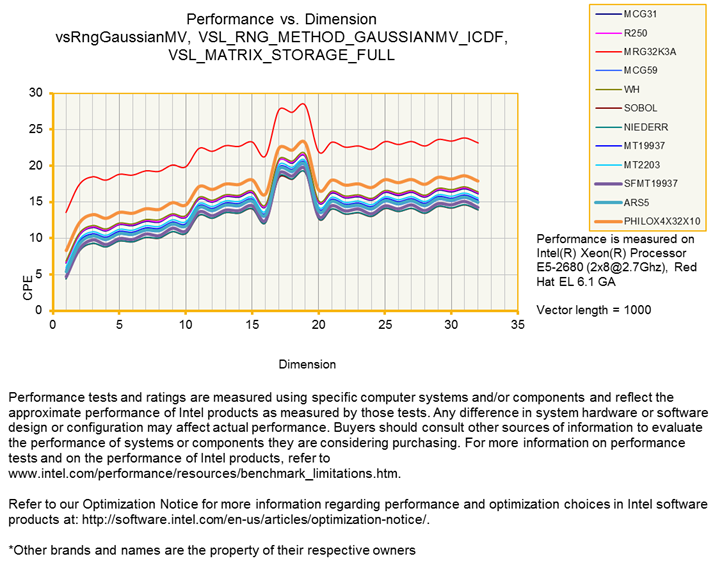Developer Reference
Visible to Intel only — GUID: GUID-78C94B79-DB71-48C3-84C1-E840736C2218
Visible to Intel only — GUID: GUID-78C94B79-DB71-48C3-84C1-E840736C2218
Intel® oneAPI Math Kernel Library Vector Statistics Random Number Generator Performance Data
Performance data obtained using vector statistics (VS) random number generator (RNG) including CPE (clocks per element) unit of measure, basic random number generators (BRNG), generated distribution generators, and length of generated vectors.
The CPE unit of measure is used when calculating the number of random numbers generated by RNGs, which is independent from the processor clock rate. For example, if the generator performance is equal to 10 CPE and the processor rate is 1 GHz, the generator will produce 108 random numbers per second.
VS BRNGs differ from each other in speed; therefore, data on performance of general (discrete and continuous) distribution generators is given separately for each BRNG used as an underlying generator to produce uniformly distributed random numbers.
Performance of a general distribution generator also depends on a method chosen for transforming a uniform distribution to a given non-uniform one. This requires specifying the applied transformation method as well.
The length of a generated vector is another factor influencing the performance of the VS vector-type generators. Calling generators on short vector lengths may prove highly ineffective. See the figure for the typical interdependence between the generator performance and the vector length.
The tables of RNG performance provide speed data obtained using the most indicative vector length of 1000 elements. For other vector lengths, the performance of any generator behaves approximately in the same way, as shown in the following graph.

Benchmark Source: Intel Corporation
Generator performance may vary according to probability distribution parameters. The tables provide performance data only for fixed parameter values (or fixed intervals of parameter variations). Table footnotes contain parameters with which a given performance is obtained. For some transformation methods the performance is approximately the same on a wide range of parameters, such methods being called uniformly fast, while for others the performance may vary considerably with variation in the distribution parameters, for example, in PTPE method for an RNG of Poisson distribution. When the latter is the case, graphs of interdependence between the performance and the distribution parameters are provided.